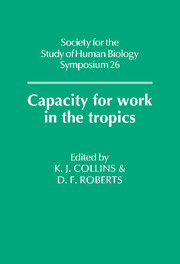Book contents
- Frontmatter
- Contents
- Preface
- Measurement of Working Capacity in Populations
- Functional Consequences of Malnutrition
- Growth, Stature and Muscular Efficiency
- Ethnic and Socio-Cultural Differences in Working Capacity
- Genetics of working capacity
- Working capacity in different African groups
- Environmental, genetic and leg mass influences on energy expenditure
- Sociocultural influences on the working capacity of elderly Nepali men
- Energy Expenditure and Endemic Disease
- Research Models in Tropical Ecosystems
- Index
Sociocultural influences on the working capacity of elderly Nepali men
Published online by Cambridge University Press: 15 March 2010
- Frontmatter
- Contents
- Preface
- Measurement of Working Capacity in Populations
- Functional Consequences of Malnutrition
- Growth, Stature and Muscular Efficiency
- Ethnic and Socio-Cultural Differences in Working Capacity
- Genetics of working capacity
- Working capacity in different African groups
- Environmental, genetic and leg mass influences on energy expenditure
- Sociocultural influences on the working capacity of elderly Nepali men
- Energy Expenditure and Endemic Disease
- Research Models in Tropical Ecosystems
- Index
Summary
The influence of sociocultural factors on physical working capacity is often ignored or treated as a residual category of little interest. Most catalogues of the factors influencing physical working capacity consider the sociocultural environment as “noise” to control for when analysing what are taken to be “basic” physiological parameters of interest. It is common, therefore, for exercise physiologists to focus on those factors that can directly generate variation in the cardiorespiratory components of physical working capacity, for example on activity or nutritional status, while ignoring sociocultural parameters. Such factors, however, are rarely distributed uniformly and homogeneously in populations, and this distributional variation is determined to a large extent by sociocultural forces. Consequently, an ecological or population perspective on physical work capacity requires consideration of sociocultural factors.
Measuring sociocultural variables, however, is often problematical. Not only are different variables important in different populations (e.g. caste vs. class), but they are often not objectively quantifiable on a universal scale analogous to temperature or haemoglobin concentration. Consequently, determining the relevant sociocultural variables to measure, deciding how to measure them, and then comparing subpopulations or populations, present formidable hurdles to the biological researcher.
A cursory examination of the literature reveals several common ways of dealing with the issue of sociocultural factors, none of which is completely satisfactory. One way has been simply to ignore the possibility of socioculturally generated variation and describe the population under investigation as “peasants”, “natives”, “residents”, etc., i.e. as a category undifferentiated apart from age and sex.
- Type
- Chapter
- Information
- Capacity for Work in the Tropics , pp. 215 - 226Publisher: Cambridge University PressPrint publication year: 1988
- 3
- Cited by



